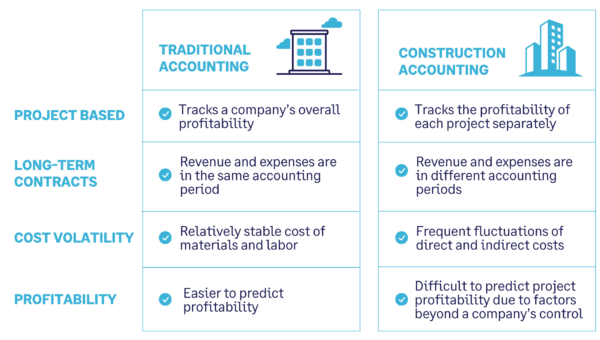Uncovering the Hurdles and Strategies in Modern Construction Accounting
Mastering Building And Construction Bookkeeping: Important Tips for Financial Success in the Industry
Mastering building bookkeeping is an important part for economic success within the sector, as it incorporates numerous techniques that straight influence task productivity. Discovering these forgotten approaches might expose chances that might transform your method to building bookkeeping.
Understanding Construction Accounting Basics
Recognizing the principles of building and construction accountancy is vital for efficient project management and economic oversight in the building and construction industry. Building and construction audit varies substantially from conventional bookkeeping practices as a result of the special difficulties posed by project-based job, including variable costs, rising and fall timelines, and complicated regulatory needs.
A crucial aspect of building and construction accountancy is job setting you back, which includes tracking expenditures for each details job. This method enables professionals to properly evaluate profitability and make educated financial choices. Additionally, building and construction bookkeeping incorporates making use of progression billing, where billings are issued based upon the percentage of work finished, guaranteeing cash money flow is preserved throughout the project lifecycle.
One more essential element is the monitoring of change orders, which represent alterations to the original contract extent. Proper paperwork and audit for these changes are crucial to prevent financial conflicts and make certain accurate job budgeting.
Last but not least, understanding the significance of conformity with sector laws and tax demands is vital. Exact economic reporting and adherence to accounting requirements not only secure versus lawful concerns but likewise improve the reputation of construction firms. Mastering these fundamentals sets the structure for reliable economic monitoring within the construction industry.
Effective Project Budgeting Techniques
Efficient task budgeting methods are vital for making sure that construction tasks stay financially feasible and on course. A well-structured spending plan acts as a roadmap, assisting task supervisors via the intricacies of building and construction expenses. To start, it is vital to develop a thorough range of job that lays out all required tasks and deliverables. This quality assists in accurately approximating expenses.
Next, employing historical data from previous tasks can substantially improve the accuracy of spending plan price quotes. By assessing previous expenses, teams can identify cost patterns and prospective challenges. In addition, involving stakeholders during the budgeting process cultivates transparency and secures buy-in, which can mitigate disputes in the future.
Furthermore, taking on a detailed line-item budget allows for precise monitoring of expenses connected with products, labor, and overhead. This granularity makes it possible for job managers to recognize differences early and readjust approaches as necessary. Additionally, incorporating backup allocations within the spending plan can aid represent unpredicted expenditures, guarding the job versus financial strain.
Finally, normal budget plan examines throughout the task lifecycle ensure that monetary objectives continue to be straightened with job goals, helping with prompt treatments when required. Implementing these techniques can considerably add to the economic health and success of building and construction jobs.
Simplifying Expense Tracking Processes
Accurate expense this website tracking processes are important in the building sector, as they often figure out the monetary success of a job. Reliable tracking enables task managers to monitor costs in real-time, guaranteeing they stay within budget plan and can make informed decisions promptly. To simplify these procedures, it is essential to adopt an organized method that incorporates innovation and recognized methods.
First, using specific construction accounting software application can automate information entrance and coverage, lessening human mistake and raising performance. construction accounting. Such software commonly consists of attributes for tracking labor, products, and subcontractor costs, providing an extensive view of task expenses
2nd, systematizing treatments for recording prices across tasks improves uniformity and streamlines evaluation. Developing a clear graph click resources of accounts tailored to the unique requirements of building projects can help with exact classification of costs.
Last but not least, normal training for team on the relevance of precise expense monitoring and the devices used while doing so promotes accountability. By carrying out these approaches, building and construction companies can substantially improve their price tracking processes, leading to improved monetary control and project success. Eventually, a well-structured approach to cost monitoring lays the groundwork for effective project administration and lasting financial sustainability.
Managing Cash Money Circulation Successfully

On a regular basis monitoring cash money flow statements is necessary. By assessing cash money inflows and outflows, services can determine fads and prospective deficiencies. This practice promotes timely adjustments to costs or repayment routines, protecting against money lacks that can threaten project timelines.

Lastly, maintaining an economic pillow or credit line can give a safeguard during lean periods. Making use of these methods will lead to a much more secure monetary foundation, allowing building companies to browse the sector's fundamental uncertainties with better confidence.
Preventing Usual Bookkeeping Pitfalls
In the complicated landscape of building accountancy, preventing common challenges is necessary for keeping economic integrity and task success. Building and construction tasks usually include countless deals, and falling short to document them effectively can lead to inconsistencies and economic losses.
Another mistake is the mismanagement of adjustment orders. Change orders are an all-natural component of building jobs, yet without appropriate audit for these adjustments, business may struggle to redeem costs. Establishing a clear process for documenting and authorizing change orders can mitigate this danger.
In addition, disregarding to integrate accounts regularly can lead to imprecise financial declarations and hinder decision-making. Regular settlement makes sure that records straighten with financial institution declarations and task paperwork.
Finally, neglecting tax obligation responsibilities can have serious consequences. It is necessary to stay notified concerning tax laws specific to the building sector, consisting of sales tax on products and labor.
Verdict
Grasping building and construction bookkeeping is important for accomplishing economic success within the market. Focusing on conformity and resolving usual audit pitfalls strengthens reputation and sustains long-lasting success, eventually promoting a sustainable competitive advantage in the building and construction sector.